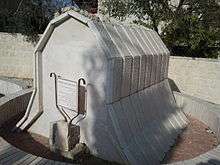Eliyahu de Vidas

Eliyahu de Vidas (1518–1592, Hebron) was a 16th-century rabbi in Ottoman Palestine. He was primarily a disciple of Rabbis Moses ben Jacob Cordovero (known as the Ramak) and also Isaac Luria.[1] De Vidas is known for his expertise in the Kabbalah. He wrote Reshit Chochmah, or "The Beginning of Wisdom," a pietistic work that is still widely studied by Orthodox Jews today. Just as his teacher Rabbi Moses Cordovero created an ethical work according to kabbalistic principles in his Tomer Devorah, Rabbi de Vidas created an even more expansive work on the spiritual life with his Reishit Chochmah. This magnum opus is largely based on the Zohar, but also reflects a wide range of traditional sources. The author lived in Safed and Hebron, and was one of a group of prominent kabbalists living in Hebron during the late 16th and early 17th-century.
Menachem Mendel of Kamenitz, the first hotelier in the Land of Israel,[2] references his visit to the grave of Eliyahu de Vidas in his 1839 book Sefer Korot Ha-Itim.[3] He states, "here I write of the graves of the righteous to which I paid my respects." After describing the Cave of Machpela and the tombs of such Biblical figures as Ruth and Jesse, Othniel Ben Knaz and Abner Ben Ner, he reports, "I also went to a grave said to be that of the Righteous Rav, author of "Reshit Hokhma." Today the grave site has been refurbished [4] and can be visited in the Old Jewish Cemetery in Hebron.
Notes
- ↑ Fine 2003, pp. 81: "Cordovero was the teacher of what appears to have been a relatively loose knit circle of disciples. The most important Elijah de Vidas, Abraham Galante, Moses Galante, Hayyim Vital, Abraham ben Eliezer ha-Levi Berukhim, Eleazar Azikri, Samuel Gallico, and an important kabbalist who studied with Cordovero for a short while in the 1560s, Mordechai Dato."
- ↑ "The first Holy Land hotelier". The Jerusalem Post. Retrieved 2016-01-11.
- ↑ ""Book of the Occurrences of the Times to Jeshurun in the Land of Israel" by David G. Cook and Sol P. Cohen". repository.upenn.edu. Retrieved 2016-01-11.
- ↑ "Hebron: A Hebron Community - Hebron, Ciy of the Patriarchs - Official web site of the Jewish Community of Hebron". www.hebron.com. Retrieved 2016-01-11.
References
- Fine, Lawrence (2003). Rodrigue, Aron; Zipperstein, Steven J, eds. Physician of the Soul, Healer of the Cosmos: Isaac Luria and His Kabbalistic Fellowship. Stanford, CA: Stanford University Press. p. 480. ISBN 0-8047-4826-8. Retrieved 2010-08-16.
- Koch, Patrick B. (2016). Human Self-Perfection: A Re-Assessment of Kabbalistic Musar-Literature of Sixteenth Century Safed. Los Angeles: Cherub Press. ISBN 1933379553.
- Photo of the grave of Eliyahu de Vidas from the Old Jewish Cemetery of Hebron
- Video of the grave of Eliyahu de Vidas from the Old Jewish Cemetery of Hebron (starts at 1:19)
- Video of the grave of Eliyahu de Vidas from the Old Jewish Cemetery of Hebron (starts at 11:32)